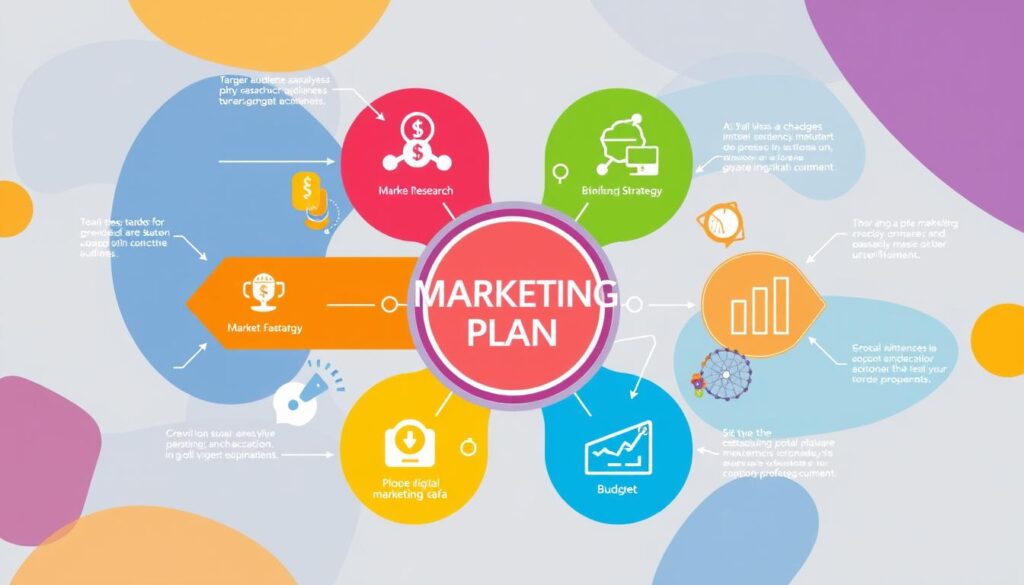To succeed in business, having a solid marketing plan is key. It acts as a roadmap to reach your target audience. Without a clear plan, your marketing can confuse people and hurt your business.
For small businesses, a good marketing plan is vital. It helps you understand what your market needs, stand out from competitors, and share your brand’s message. This way, you can connect with your audience effectively.
Key Takeaways
- A marketing plan is a strategic document that outlines your business’s marketing goals, target audience, promotional tactics, branding, budgeting, and market analysis.
- Developing a marketing plan is vital for small businesses to ensure coherent marketing efforts, articulate objectives, conduct competitive analysis, and define pricing strategies.
- Effective marketing plans include SMART goals, target audience definition, budget allocation, and incorporation of digital marketing tactics like content marketing, email marketing, SEO, and social media.
- Branding and reputation management are essential components of a successful marketing plan for small businesses.
- Regularly measuring and optimizing your marketing efforts is crucial to ensure your plan remains effective and adapts to changing market conditions.
What is a Small Business Marketing Plan?
A marketing plan is a roadmap for a small business. It shows how to talk to its audience online and offline. It aims to promote products or services.
The purpose of a marketing plan is to help businesses meet their goals. Goals can be to get more leads, increase sales, or boost brand awareness.
The components of a marketing plan depend on the business size and goals. It should outline desired outcomes, the target audience, and strategies to reach them. A good marketing plan keeps a business on track and ensures marketing efforts match the business strategy.
To make a great marketing plan, you need to know your audience well. You must also set clear marketing goals and plan how to reach and engage with customers. This plan acts as a guide for small businesses, helping them make smart marketing choices.
“A well-crafted marketing plan can be the difference between success and failure for a small business.”
For any small business, a detailed marketing plan is key. It ensures marketing efforts align with business goals and objectives.
The Importance of a Marketing Plan for Small Businesses
A good marketing plan is key for small businesses to succeed. It acts as a guide, helping you find your target audience and understand market needs. It also helps you stand out from competitors. In fact, businesses with a marketing plan are 57% more likely to make more money than those without one.
Key Benefits of a Marketing Plan
A strategic marketing plan offers many benefits to small businesses:
- More revenue and growth: Small businesses with a marketing plan are 77% more likely to grow their revenue and last longer.
- Better customer engagement and retention: Businesses with a marketing plan see a 43% increase in customer engagement and retention.
- Successful expansion and new product launches: Small businesses with a marketing plan are 63% more likely to expand or launch new products successfully.
- Setting and measuring goals effectively: Businesses that set SMART marketing goals are 36% more likely to reach their marketing goals.
In short, a well-made marketing plan is crucial for guiding small businesses. It helps them take efficient and profitable actions, adapting to changes in their business world.
How to Create a Small Business Marketing Plan
Making a good small business marketing plan is key to growing your business. It helps you reach the right people. Let’s look at the main steps to make a plan that meets your business goals.
Step 1: Set SMART Marketing Goals
Start by setting specific, measurable, achievable, relevant, and time-bound (SMART) marketing goals. For example, aim to increase website traffic by 20% in 6 months. Or, try to add 500 new email subscribers in a quarter. Clear goals help you track your progress and make smart choices.
Step 2: Define Your Target Audience
Do deep research to understand your target audience. Know their demographics, interests, problems, and how they buy things. This lets you make marketing that speaks to your perfect customers, saving you money.
Step 3: Establish Your Marketing Budget
Figure out a marketing budget that fits your goals and what you can afford. Think about costs for making content, ads, software, events, and outside marketing help. Spend your money wisely to get the most from your marketing.
By following these steps, you’re on the path to a solid small business marketing plan. It will help your business grow and connect with your audience. A good plan is the base for successful marketing.
Essential Components of a Successful Marketing Plan
Creating a detailed small business marketing plan is key to reaching your growth goals. It should include several important parts to work well and last long. Let’s look at the main parts of a strong marketing strategy for your small business.
Define Your Marketing Goals
Begin by setting SMART (Specific, Measurable, Achievable, Relevant, and Time-bound) marketing goals. These goals should match your business’s overall aims. They are the base of your marketing plan. Examples include boosting brand awareness, getting a certain number of leads, or hitting a sales revenue target.
Identify Your Target Audience
Do a deep dive into who your target audience is. Know their demographics, what they like, their problems, and how they buy things. This info helps you make your marketing messages and plans fit your ideal customers perfectly.
Establish Your Marketing Budget
Set aside a budget that makes sense for your marketing. Think about the cost of ads, making content, digital tools, and other marketing costs. Make sure your budget fits your marketing goals and what your small business can handle.
Outline Your Marketing Strategies
- Content Marketing: Create a content plan with blog posts, social media, and more to draw in and keep your audience.
- Email Marketing: Use emails to keep leads and customers interested and to promote your offerings.
- Search Engine Optimization (SEO): Make your website and online presence better to show up more in search results.
- Pay-Per-Click (PPC) Advertising: Use platforms like Google Ads or social media ads to get more visitors and leads.
- Social Media Marketing: Be active on the right social media sites and talk to your audience to grow your brand and loyalty.
Measure and Optimize
Always watch and study how well your marketing is doing. Look at website visits, lead numbers, conversion rates, and how much it costs to get a customer. Change your strategies based on what you learn to make your marketing better.
Adding these key parts to your small business marketing plan will give you a solid plan for growth. It helps you reach your audience and meet your marketing goals.

| Marketing Plan Component | Description |
|---|---|
| SMART Marketing Goals | Set specific, measurable, achievable, relevant, and time-bound marketing objectives |
| Target Audience | Identify and understand your ideal customers’ demographics, psychographics, and buying behaviors |
| Marketing Budget | Allocate a realistic budget for your marketing activities, considering various expenses |
| Marketing Strategies | Outline your content marketing, email marketing, SEO, PPC, and social media marketing tactics |
| Measurement and Optimization | Track key metrics, analyze performance, and continuously refine your marketing strategies |
How to create a small business marketing plan
Creating a good marketing plan is key for your business to grow. It helps you know your audience, set goals, and pick the best ways to reach them. Here are the steps to make a small business marketing plan:
- Conduct a SWOT Analysis: First, find out what your business is good at, what it struggles with, and what opportunities and threats it faces. This analysis gives you a clear view of where you stand and guides your marketing choices.
- Set SMART Marketing Goals: Make specific, measurable, achievable, relevant, and timely goals for your marketing. These could be to get more people to know your brand, visit your website, or become customers.
- Define Your Target Audience: Learn all you can about who your ideal customers are. Use details like demographics, behaviors, and what they buy to tailor your marketing to them.
- Allocate a Marketing Budget: Decide how much money you can spend on marketing. Small businesses usually spend about 1% of their income on marketing to promote their offerings.
- Outline Your Marketing Strategies: Create a detailed plan that includes different marketing tactics like content, email, SEO, and social media. Make sure these strategies match your goals for the best results.
- Implement and Monitor Your Plan: Start your marketing plan and watch how it does. Keep an eye on it and change your strategies as needed to get the best results.
By taking these steps, you’ll make a marketing plan that helps you connect with your audience. This will help your business grow and succeed.
“A well-crafted marketing plan is the foundation for a successful small business.” – Marketing expert, Jane Doe
Promotional Tactics for Small Businesses
As a small business owner, you have many ways to promote your business. You can use content marketing, social media, and more. These methods help you reach your audience, build your brand, and increase sales. Let’s look at some top marketing tactics for small businesses:
Content Marketing
Content marketing is about creating and sharing valuable content. This can be blog posts, videos, or social media posts. It helps educate and engage your audience. By doing this, you build trust and show your expertise, leading to more sales.
Email Marketing
Email marketing is a cost-effective way to connect with your audience. By sending personalized emails, you can nurture leads and promote your products. With more people shopping online, email marketing is key for small businesses.
Search Engine Optimization (SEO)
SEO helps your website show up in search results. By optimizing your content, you attract more visitors. This can lead to more customers finding your business online.
Pay-Per-Click (PPC) Advertising
PPC ads can be effective for small businesses. Platforms like Google Ads and Facebook Ads let you target specific audiences. This way, you can test ads and see how they perform.
Social Media Marketing
Being active on social media helps you connect with your audience. Create a strong brand identity and post engaging content. Use influencers to grow your following and drive sales. Focus on platforms like Facebook, YouTube, and Instagram.
Remember, trying different marketing tactics is key. Track your results and adjust your strategy as needed. This way, you can stay ahead in the market.

“Addressing both positive and negative feedback promptly can influence potential customers’ decisions, showcasing how businesses treat their clients.”
Branding and Reputation Management
As a small business owner, building a strong brand and managing your online reputation are key. They help win customer trust and loyalty, which is vital for your business’s growth.
Small business branding means creating a unique look, voice, and message that speaks to your audience. A strong brand helps you stand out and connect deeply with customers.
Reputation management is also crucial. Today, 77% of people check reviews when looking at local businesses. And 79% expect quick responses on social media. Keeping a good online image is essential for trust and loyalty.
| Key Reputation Management Strategies | Benefits |
|---|---|
|
|
Good small business branding and reputation management build a strong, trustworthy brand. By focusing on great customer experiences and managing your online image, you set your business up for success.
Measuring and Optimizing Your Marketing Efforts
It’s key to check and tweak your small business marketing plan often. This ensures it keeps working well over time. By watching important numbers, you learn what’s working and what’s not. This helps you make smart choices to boost your marketing.
Some key numbers to watch include:
- Website traffic
- Lead generation
- Conversion rates
- Email open and click-through rates
- Social media engagement
Looking at these numbers tells you which marketing moves are best. For instance, if your emails aren’t getting opened, tweak your subject lines or send times. If lots of people visit your site but don’t buy, your landing pages or calls to action might need work.
| Metric | Current Performance | Target Performance |
|---|---|---|
| Website Traffic | 5,000 unique visitors per month | 10,000 unique visitors per month |
| Lead Generation | 500 leads per month | 750 leads per month |
| Conversion Rate | 2% | 5% |
| Email Open Rate | 20% | 30% |
| Social Media Engagement | 1,000 engagements per month | 2,000 engagements per month |
By checking these numbers often and adjusting your marketing plan optimization, you keep your marketing strong. This helps your small business grow and succeed.
“Measurement is the first step that leads to control and eventually to improvement. If you can’t measure something, you can’t understand it. If you can’t understand it, you can’t control it. If you can’t control it, you can’t improve it.”
– H. James Harrington
Conclusion
A well-made small business marketing plan is key to growing your company. It helps you set clear goals, know your audience, and use the right marketing tactics. This way, you can promote your products or services well and reach your business goals.
Having a good marketing plan brings many benefits. For example, 63% of small businesses that grew and made more money had a solid marketing plan. Also, 80% think it keeps them on the right track. Plus, businesses with clear marketing goals are 42% more likely to succeed than those without.
To keep your marketing working well, always check and improve your strategies. This helps you make smart choices, stay ahead in the market, and grow your business. With a strong summary of small business marketing plan, you can reach your business’s full potential and keep growing.
FAQ
What is a small business marketing plan?
A marketing plan is a roadmap for talking to your audience. It shows how you’ll promote your products or services. It outlines your goals and the strategies to reach them.
Why is a marketing plan important for small businesses?
A marketing plan is vital for small businesses. It helps you understand your market and who you’re selling to. It guides your sales and branding efforts, helping your business grow.
What are the key steps to create a small business marketing plan?
To make a marketing plan, start by setting clear goals. Then, define your audience and budget. Finally, choose the right promotional tactics.
What are the essential components of a small business marketing plan?
A good marketing plan includes several key parts. These are the executive summary, market analysis, and marketing strategies. It also covers promotional tactics, branding, and how to measure success.
What promotional tactics can small businesses leverage?
Small businesses can use many tactics to reach their audience. These include content marketing, email marketing, SEO, PPC ads, and social media.
Why is it important to measure and optimize a small business marketing plan?
Measuring and optimizing your marketing plan is key. It helps keep your efforts effective over time. Track things like website traffic and social media engagement to see how you’re doing.
Resources:
Explore our curated list of recommended resources for printing, design, and free media assets. Whether you need professional printing services, free design templates, or royalty-free photos for your next project, these reliable sites have you covered.1. Printing & Design
- Printing Inc. Description: Singapore-based online printing service offering a variety of print products such as business cards, flyers, brochures, and custom stickers with professional design services.
- Namecards Inc. Description: Specialist in name card printing, providing a wide range of custom designs, finishes, and materials for high-quality business cards.
- Kian Hong Press Description: Established corporate printing company in Singapore, offering solutions for brochures, catalogs, annual reports, and other corporate stationery.
2. Free Design Templates
- Canva Description: Offers a wide range of free and customizable templates for various needs, including presentations, posters, social media, and marketing materials.
- FreePik Description: Provides thousands of free and premium templates for brochures, flyers, business cards, and more, along with editable vector illustrations and graphics.
- Piktochart Description: Focused on data visualization and professional templates for infographics, posters, presentations, and reports, with both free and premium options.
3. Free Royalty-Free Photos
- Pexels Description: Offers high-quality, free stock photos and videos shared by talented creators for commercial and personal use without attribution.
- Unsplash Description: A large collection of beautiful, high-resolution images contributed by photographers worldwide, available for free use in any project.
- Pixabay Description: A community-driven platform offering copyright-free photos, illustrations, and videos for use in any creative project, with no licensing restrictions.






